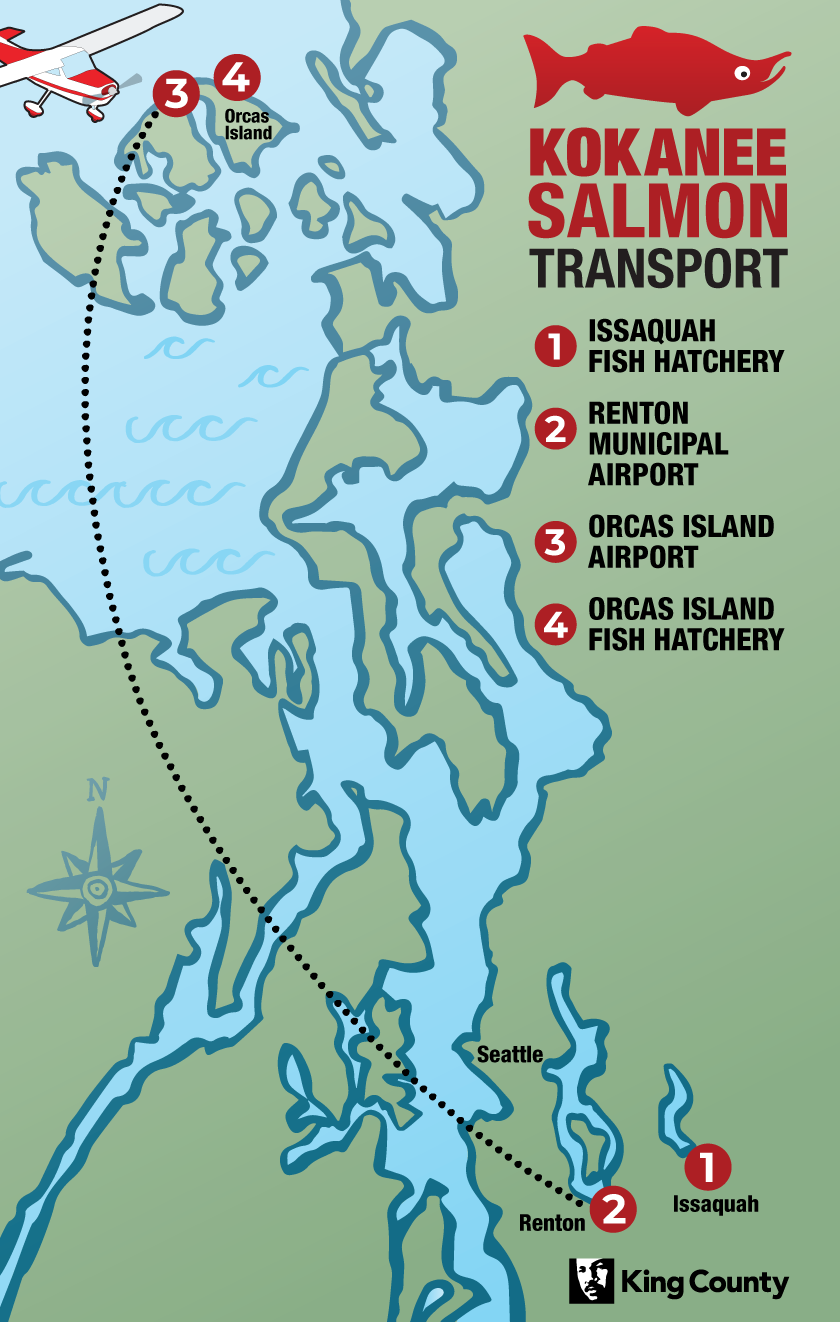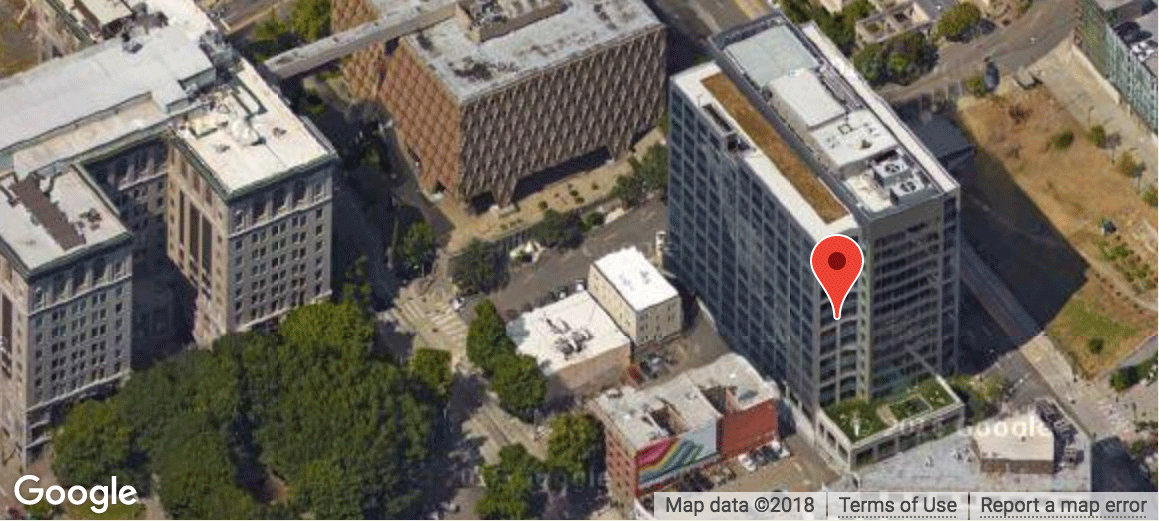Small planes fly kokanee salmon to Orcas Island hatchery, the latest emergency action by King County and partners to ensure the native species’ survival
Summary
Volunteer pilots helped King County and its conservation partners fly Lake Sammamish kokanee salmon raised at a hatchery in Issaquah to Long Live the Kings’ hatchery on Orcas Island, the latest emergency action to ensure the survival of a native species that is important to the region’s bio-diversity.
Story
King County and its conservation partners teamed up local pilots to fly Lake Sammamish kokanee salmon from an Issaquah hatchery to one located on Orcas Island, the latest emergency action to prevent the possible extinction of the native species.
The Lake Sammamish Kokanee Work Group partnered with LightHawk, a nationwide nonprofit organization that offers small aircraft flights to advance conservation efforts that require fast, safe transport. The hatchery operators on Orcas Island, Long Live the Kings, offered their facility to help with the recovery effort following a sudden, alarming decline in the number of spawners returning to Lake Sammamish streams.
“We are crossing land, air, and sea to try to save our native kokanee salmon,” said King County Executive Dow Constantine. “It is inspiring to have volunteers join our coalition to prevent the extinction of a salmon species that is important to our history and habitat."
The 9-month-old fish will be raised to adult at Long Live the Kings’ facility and their offspring will later return to Lake Sammamish, boosting the fish population. Raising the fish at the hatchery on Orcas Island will shield them from potentially hazardous conditions in Lake Sammamish – including high temperatures, low oxygen levels, and voracious non-native predators – that biologists believe contributed to the recent population crash.
Having kokanee salmon located in multiple locations also prevents a loss of the entire species in case of a catastrophic event.
Long Live the Kings, a nonprofit founded in 1986, has an outstanding reputation for nurturing imperiled salmon and trout populations to recovery. The clean, cool spring water at their Orcas Island facility will provide a safe haven for Lake Sammamish kokanee. It helped boost Hood Canal summer chum salmon to the point where they are tone of only two salmon populations in the state are close to meeting the recovery goals.
The flight originated from Renton Municipal Airport, where the pilots met with the technical team that had transferred the fish in coolers from the Issaquah Hatchery. The pilots landed at the Orcas Island airport where the awaiting staff transferred them to their new hatchery.
The staff and volunteers adapted the interior of the airplanes to haul specially designed coolers that provide oxygen to the fish.

"For salmon recovery, LightHawk often flies media, scientists, elected officials, and more but this will be our first time flying fish,” Christine Steele, Western Program Coordinator for LightHawk. “Our staff and pilots are thrilled to provide safe, customized, rapid aerial transport for these genetically important native kokanee salmon, thus increasing the chances of their survival into the future.”
The program on Orcas Island is one of the recovery actions recommended by the Lake Sammamish Kokanee Work Group, a broad coalition that includes residents who live in the watershed, King County, the Snoqualmie Tribe, the cities of Bellevue, Issaquah, Sammamish, and Redmond, the U.S. Fish and Wildlife Service, the Washington Department of Fish and Wildlife, Washington State Parks, Trout Unlimited; Mid-Sound Fisheries Enhancement Group, Mountains to Sound Greenway Trust, Friends of Issaquah Salmon Hatchery, Save Lake Sammamish, Friends of Pine Lake, Friends of Sammamish State Park, and other partners.
Executive Constantine in May 2018 announced that the King County Department of Natural Resources and Parks would work shoulder-to-shoulder with partners to enact a wide range of actions to prevent the possible extinction of the native freshwater kokanee salmon after a startling decline in spawners returning to streams around Lake Sammamish. County, state, federal, and non-governmental biologists counted fewer than 20 kokanee during the 2017 return, five years after they counted more than 18,000.
Other actions include:
- Identifying and removing barriers that block kokanee from reaching healthy stream habitat
- Planting thousands of trees and shrubs that provide shade and cover for salmon
- Using specially designed traps to capture returning spawners for the hatchery program
- Introducing kokanee to additional creeks in the watershed, reducing the risk that a flood or drought will wipe out the entire species
- Leading and supporting scientific analysis to inform strategic actions to address the underlying factors that are threatening kokanee
A species important to the bio-diversity of the region
In addition to being culturally significant, the native kokanee are important to the bio-diversity of the region. Several scientific studies show that they have a unique genetic signature, having adapted over centuries to the unique Lake Sammamish ecosystem, making them impossible to replace. Genetic diversity makes the natural environment healthier and more resilient, which is particularly important in the face of climate change.
The kokanee run that occurs in November and December – known as “the late run” – is the only remaining native run. Biologists believe the other two runs that historically occurred between late August and early November have been extinct since the 2000s.
Relevant links
- Lake Sammamish Kokanee Work Group
- Emergency and long-range actions to ensure the survival of native kokanee salmon
- VIDEO: How King County is removing barriers to healthy salmon habitat
Quotes
We are crossing land, air, and sea to try to save our native kokanee salmon. It is inspiring to have volunteers join our coalition to prevent the extinction of a salmon species that is important to our history and habitat.
For salmon recovery, LightHawk often flies media, scientists, elected officials, and more but this will be our first time flying fish. Our staff and pilots are thrilled to provide safe, customized, rapid aerial transport for these genetically important native kokanee salmon, thus increasing the chances of their survival into the future.
We provide a flying Noah's Ark of sorts. LightHawk has lots of experience flying critically endangered wildlife for captive breeding and release into the wild. Our pilots have successfully transported dozens of California condors, Mexican wolves, whooping cranes, black-footed ferrets, red pandas, Alplomado falcons, sea turtles, etc. This is our first time flying fish, though, so that has been a fun logistical challenge to tackle.
For more information, contact:
Chad Lewis, Department of Natural Resources and Parks, 206-263-1250

 Translate
Translate

